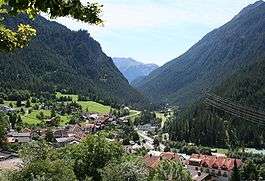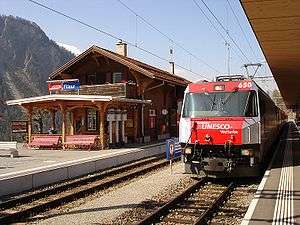Filisur
| Filisur | ||
|---|---|---|
|
View of Filisur lookin southeast, upwards towards the Albula Pass | ||
| ||
 Filisur | ||
|
Location of Filisur 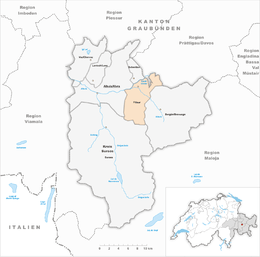 | ||
| Coordinates: 46°40′N 9°41′E / 46.667°N 9.683°ECoordinates: 46°40′N 9°41′E / 46.667°N 9.683°E | ||
| Country | Switzerland | |
| Canton | Graubünden | |
| District | Albula | |
| Area[1] | ||
| • Total | 44.49 km2 (17.18 sq mi) | |
| Elevation | 1,032 m (3,386 ft) | |
| Population (Dec 2015[2]) | ||
| • Total | 445 | |
| • Density | 10/km2 (26/sq mi) | |
| Postal code | 7477 | |
| SFOS number | 3522 | |
| Surrounded by | Alvaneu, Bergün/Bravuogn, Savognin, Schmitten, Tiefencastel, Tinizong-Rona, Davos | |
| Website |
www SFSO statistics | |
Filisur is an Alpine village and municipality in the district of Albula in the canton of Graubünden in Switzerland. The village sits on a hillside with a view to the west where the two rivers Albula/Alvra from the Albula Pass and Landwasser from Davos meet.
History
Filisur is first mentioned in 1262 as villa Fallisour.[3]
Geography
Filisur has an area, as of 2006, of 44.6 km2 (17.2 sq mi). Of this area, 18.1% is used for agricultural purposes, while 46.6% is forested. Of the rest of the land, 1.6% is settled (buildings or roads) and the remainder (33.7%) is non-productive (rivers, glaciers or mountains).[4]
The municipality is located Kreis Bergün, Bez. Albula. Strassendorf (1084 m) rechts der Albula, mit dem Weiler Jenisberg (1504 m) am linken Abhang des Landwassertales. It consists of the village of Filisur and the hamlets of Kreis Bergün, Bez. Albula. Strassendorf (1084 m) rechts der Albula, mit dem Weiler Jenisberg (1504 m) am linken Abhang des Landwassertales.
Demographics
Filisur has a population (as of 31 December 2015) of 445.[2] As of 2008, 14.1% of the population was made up of foreign nationals. Over the last 10 years the population has grown at a rate of 0.8%. Most of the population (as of 2000) speaks German (84.5%), with Italian being second most common ( 6.7%) and Romansh being third ( 3.0%).[4]
As of 2000, the gender distribution of the population was 49.5% male and 50.5% female.[5] The age distribution, as of 2000, in Filisur is; 58 people or 12.4% of the population are between 0 to 9 years old. 36 people or 7.7% are 10 to 14, and 23 people or 4.9% are 15 to 19. Of the adult population, 60 people or 12.9% of the population are between 20 to 29 years old. 57 people or 12.2% are 30 to 39, 67 people or 14.4% are 40 to 49, and 72 people or 15.5% are 50 to 59. The senior population distribution is 39 people or 8.4% of the population are between 60 to 69 years old, 31 people or 6.7% are 70 to 79, there are 17 people or 3.6% who are 80 to 89, and there are 6 people or 1.3% who are 90 to 99.[6]
In the 2007 federal election the most popular party was the FDP which received 36.5% of the vote. The next three most popular parties were the SVP (33.3%), the SPS (22%) and the CVP (6.5%).[4]
The entire Swiss population is generally well educated. In Filisur about 69.4% of the population (between age 25-64) have completed either non-mandatory upper secondary education or additional higher education (either university or a Fachhochschule).[4]
Filisur has an unemployment rate of 2.02%. As of 2005, there were 72 people employed in the primary economic sector and about 10 businesses involved in this sector. 34 people are employed in the secondary sector and there are 8 businesses in this sector. 86 people are employed in the tertiary sector, with 16 businesses in this sector.[4]
The historical population is given in the following table:[3][5]
| year | population |
|---|---|
| 1803 | 164 |
| 1850 | 280 |
| 1888 | 273 |
| 1900 | 644a |
| 1910 | 333 |
| 1950 | 375 |
| 1960 | 318 |
| 1970 | 325 |
| 1980 | 410 |
| 1990 | 413 |
| 2000 | 333 |
- ^a Population increase during construction of the Rhaetian Railway line
Weather
Filisur has an average of 109.9 days of rain per year and on average receives 893 mm (35.2 in) of precipitation. The wettest month is August during which time Filisur receives an average of 122 mm (4.8 in) of precipitation. During this month there is precipitation for an average of 12.3 days. The driest month of the year is February with an average of 43 mm (1.7 in) of precipitation over 12.3 days.[7]
Heritage sites of national significance
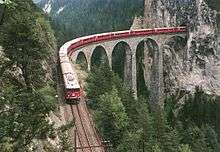
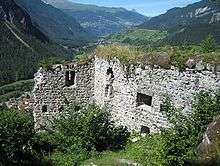
The castle ruins of Greifenstein and the Schmittentobel-Landwasser Viaduct of the Rhaetian Railway are listed as Swiss heritage sites of national significance.[8]
Transportation
Filisur's railway station is located in the northwest of the village 50 metres above the center and served by the Rhaetian Railway (RhB), the Glacier Express and the Bernina Express on the route between Chur (585 metres (1,919 ft)) and St. Moritz (1,775 metres (5,823 ft)). It is also the end station for the line to Davos.
PostBus Switzerland also operate services through the village.
References
- ↑ Arealstatistik Standard - Gemeindedaten nach 4 Hauptbereichen
- 1 2 Swiss Federal Statistical Office - STAT-TAB, online database – Ständige und nichtständige Wohnbevölkerung nach institutionellen Gliederungen, Geburtsort und Staatsangehörigkeit (German) accessed 30 August 2016
- 1 2 Filisur in German, French and Italian in the online Historical Dictionary of Switzerland.
- 1 2 3 4 5 Swiss Federal Statistical Office accessed 24-Sep-2009
- 1 2 Graubunden in Numbers Archived September 24, 2009, at the Wayback Machine. (German) accessed 21 September 2009
- ↑ Graubunden Population Statistics Archived August 27, 2009, at the Wayback Machine. (German) accessed 21 September 2009
- ↑ "Temperature and Precipitation Average Values-Table, 1961-1990" (in German, French, and Italian). Federal Office of Meteorology and Climatology - MeteoSwiss. Retrieved 8 May 2009., the weather station elevation is 1030 meters above sea level.
- ↑ Swiss inventory of cultural property of national and regional significance Archived May 1, 2009, at the Wayback Machine. 21.11.2008 version, (German) accessed 24-Sep-2009
| Wikimedia Commons has media related to Filisur. |
External links
- Official website (German)
- Filisur in German, French and Italian in the online Historical Dictionary of Switzerland.
